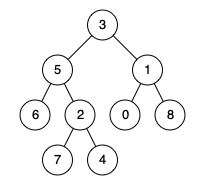Question
题目大意: 求二叉树的最小共同父节点的题
Given a binary tree, find the lowest common ancestor (LCA) of two given nodes in the tree.
According to the definition of LCA on Wikipedia: “The lowest common ancestor is defined between two nodes p and q as the lowest node in T that has both p and q as descendants (where we allow a node to be a descendant of itself).”
Given the following binary tree: root = [3,5,1,6,2,0,8,null,null,7,4]

Example 1:
Input: root = [3,5,1,6,2,0,8,null,null,7,4], p = 5, q = 1 Output: 3 Explanation: The LCA of nodes
5and1is3.
Example 2:
Input: root = [3,5,1,6,2,0,8,null,null,7,4], p = 5, q = 4 Output: 5 Explanation: The LCA of nodes
5and4is5, since a node can be a descendant of itself according to the LCA definition.
Note:
- All of the nodes' values will be unique.
- p and q are different and both values will exist in the binary tree.
Difficulty:Medium
Category:Tree
Solution
使用递归来求解,在递归函数中,我们首先看当前结点是否为空,若为空则直接返回空,若为p或q中的任意一个,也直接返回当前结点。否则的话就对其左右子结点分别调用递归函数,由于这道题限制了p和q一定都在二叉树中存在,那么如果当前结点不等于p或q,p和q要么分别位于左右子树中,要么同时位于左子树,或者同时位于右子树,那么我们分别来讨论:
- 若 p 和 q 要么分别位于左右子树中,那么对左右子结点调用递归函数,会分别返回p和q结点的位置,而当前结点正好就是p和q的最小共同父结点,直接返回当前结点即可,这就是题目中的例子1的情况。
- 若 p 和 q 同时位于左子树,这里有两种情况,一种情况是left会返回p和q中较高的那个位置,而right会返回空,所以我们最终返回非空的left即可,这就是题目中的例子2的情况。还有一种情况是会返回p和q的最小父结点,就是说当前结点的左子树中的某个结点才是p和q的最小父结点,会被返回。
- 若 p 和 q 同时位于右子树,同样这里有两种情况,一种情况是right会返回p和q中较高的那个位置,而left会返回空,所以我们最终返回非空的right即可,还有一种情况是会返回p和q的最小父结点,就是说当前结点的右子树中的某个结点才是p和q的最小父结点,会被返回,写法很简洁
Time complexity: O(n) Space complexity: O(n)
class Solution {
public:
TreeNode* lowestCommonAncestor(TreeNode* root, TreeNode* p, TreeNode* q) {
if (!root || root == p || root == q) return root;
TreeNode* l = lowestCommonAncestor(root->left, p, q);
TreeNode* r = lowestCommonAncestor(root->right, p, q);
if (l && r) return root;
return l ? l : r;
}
};